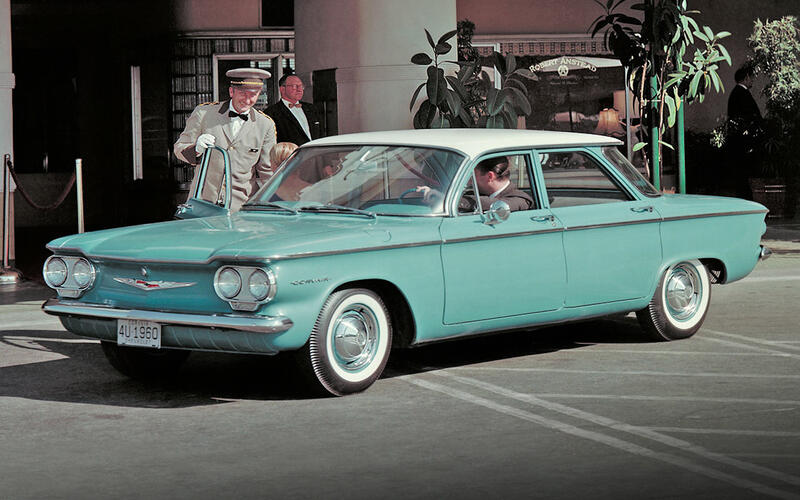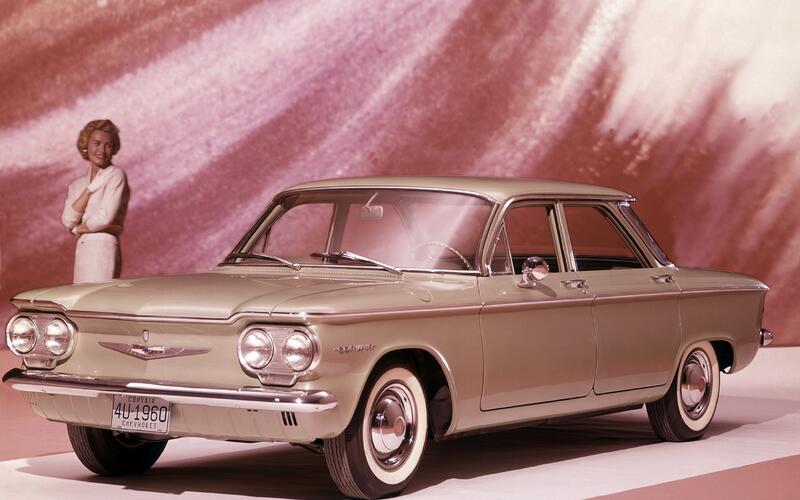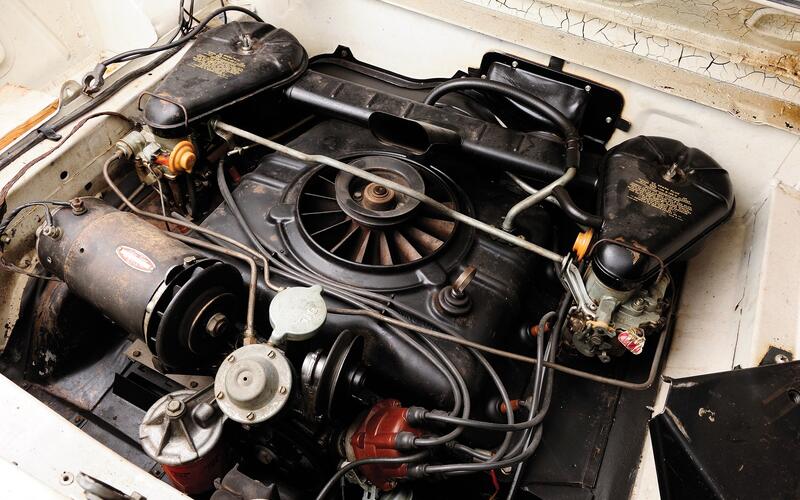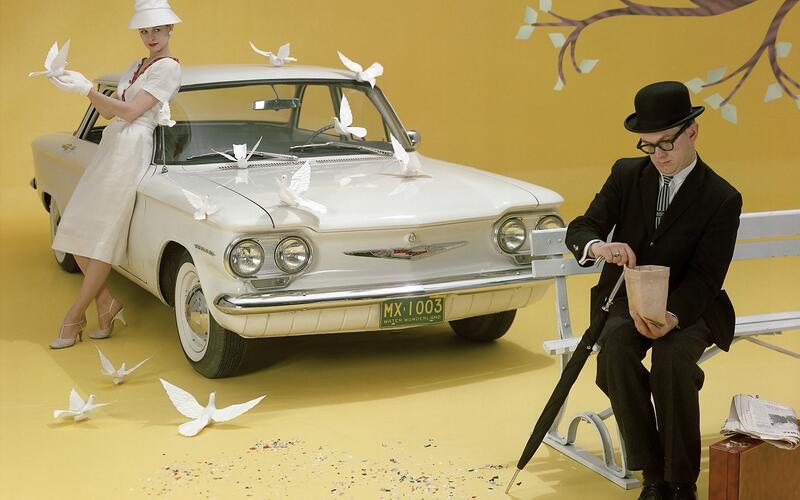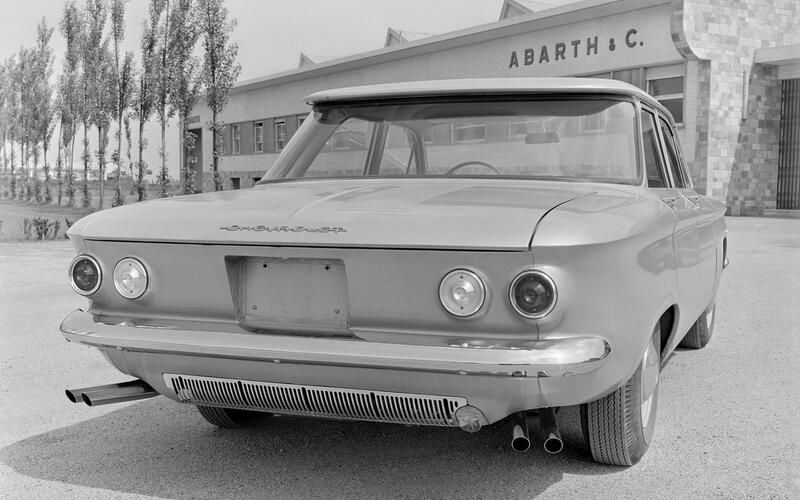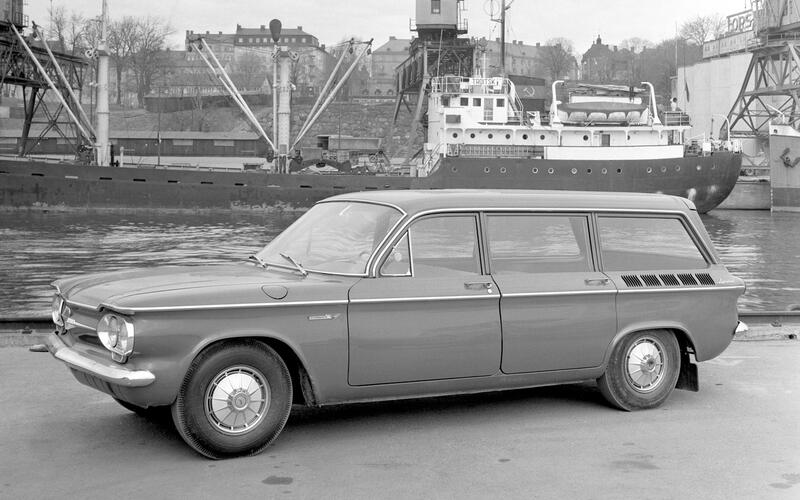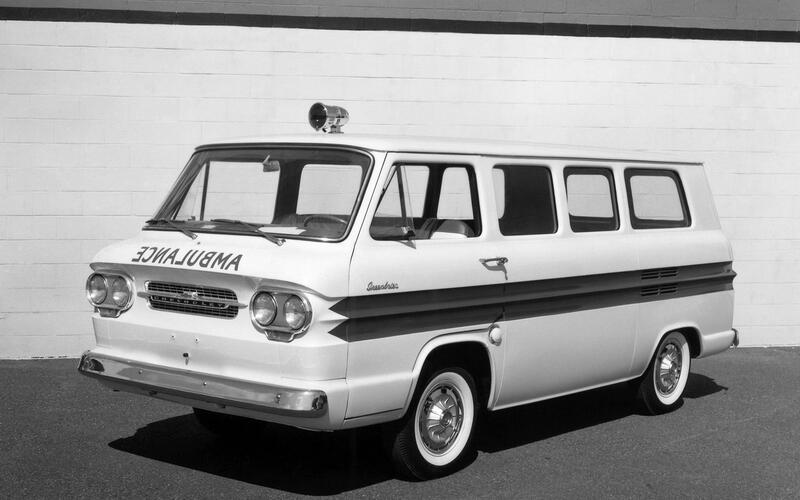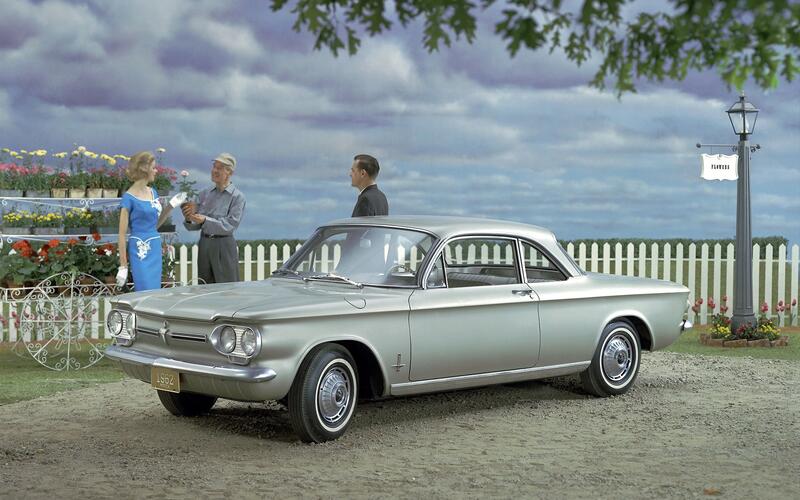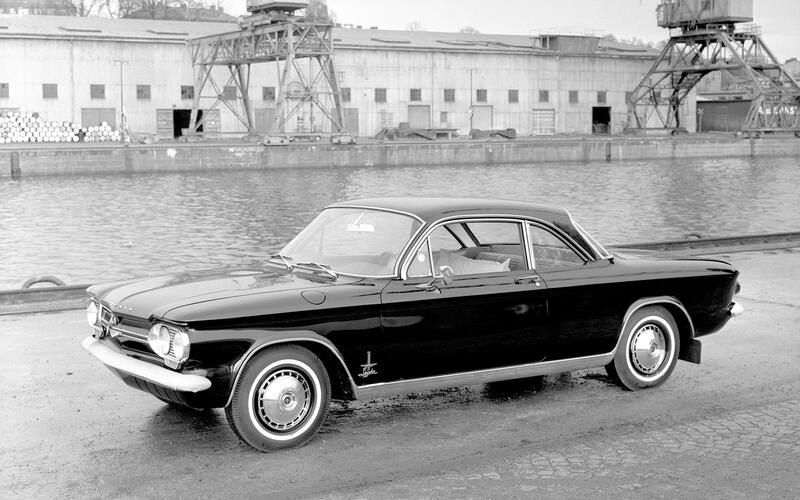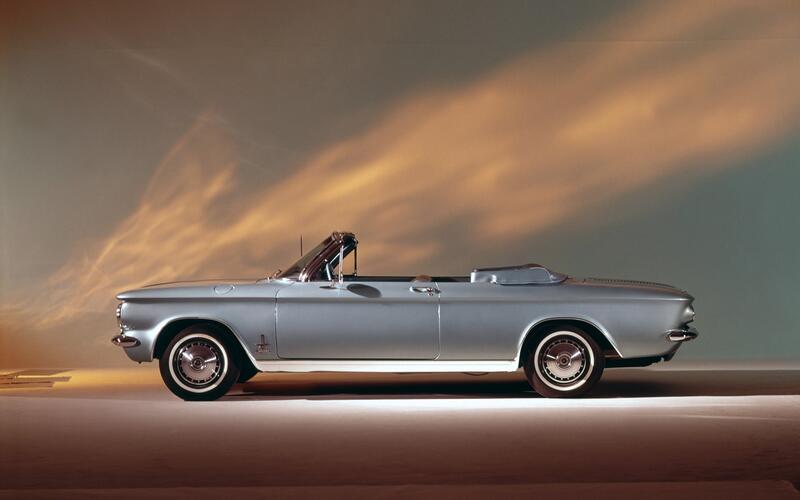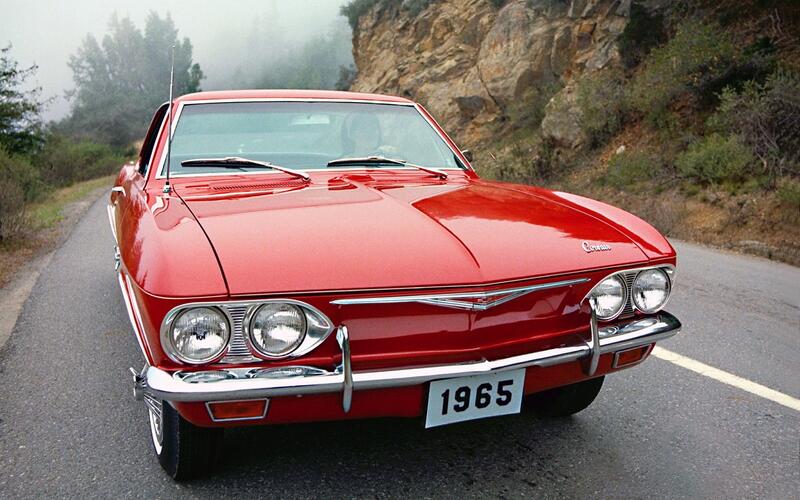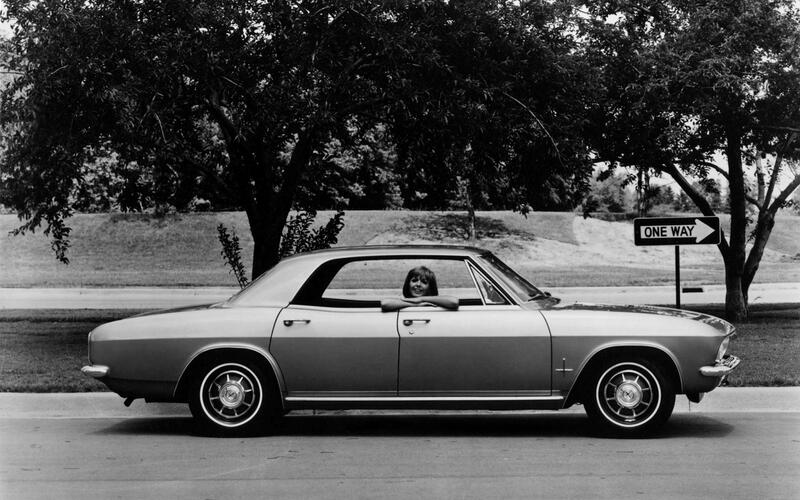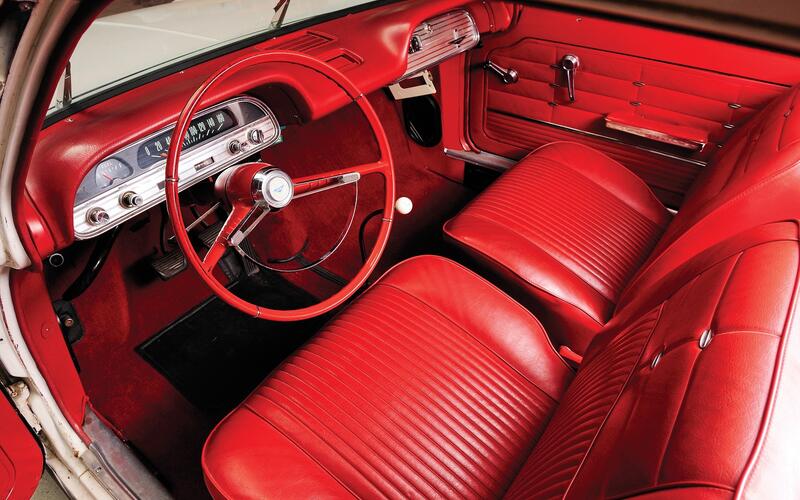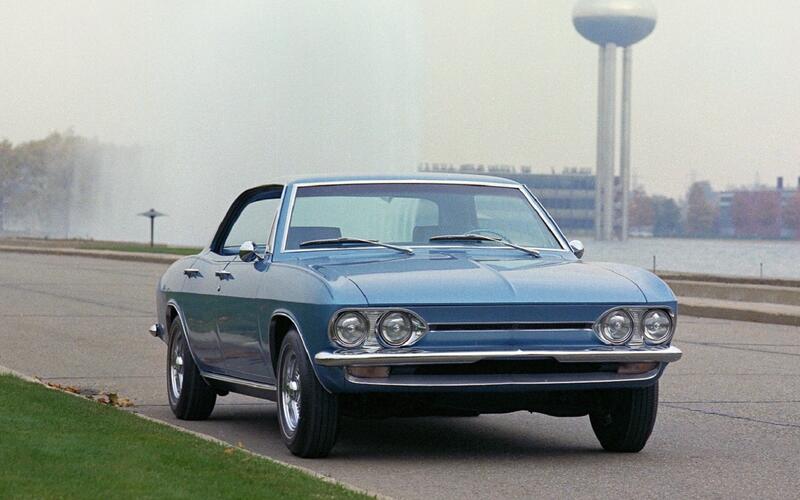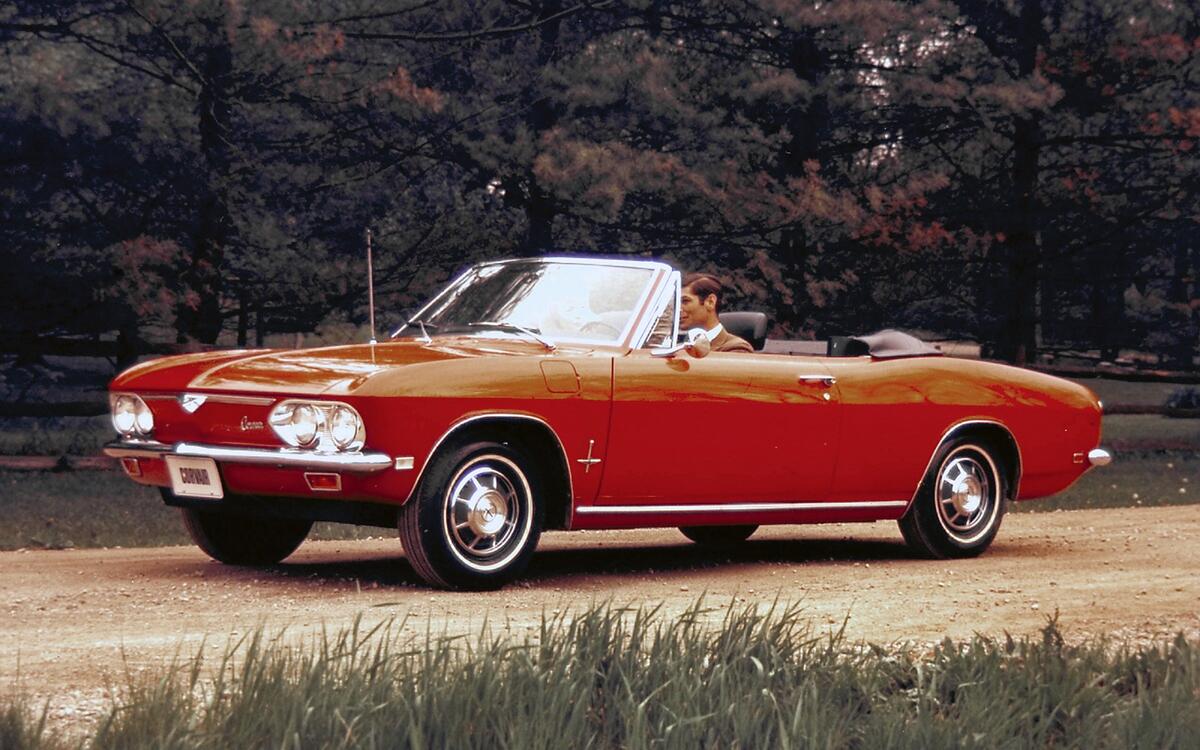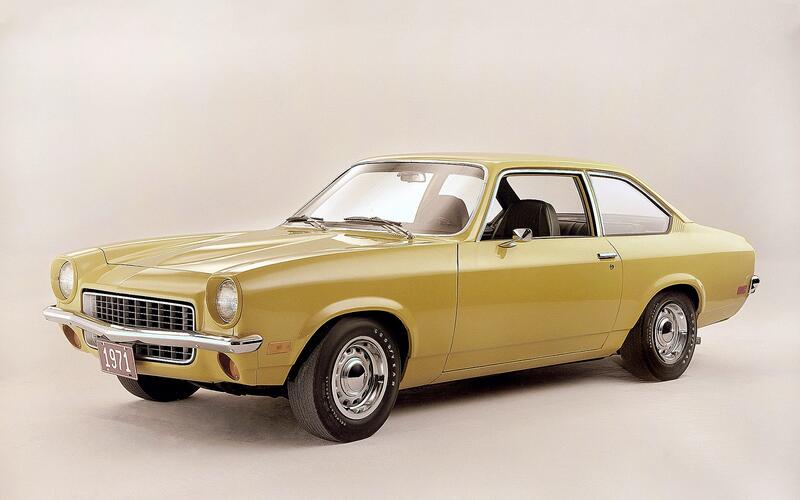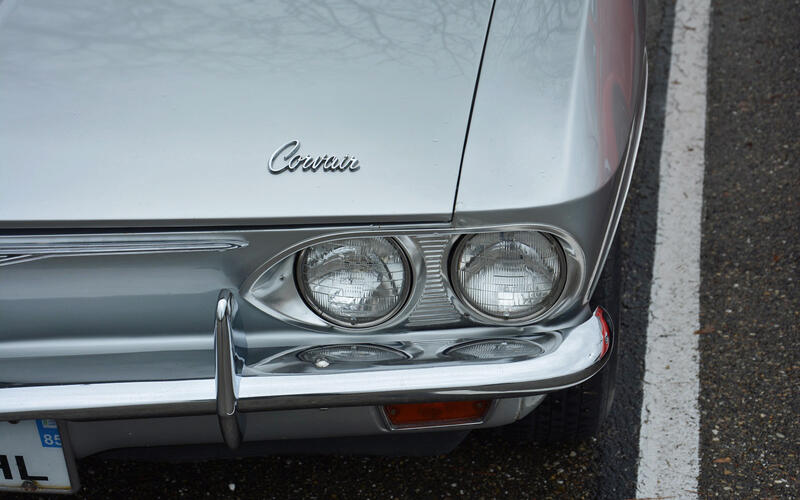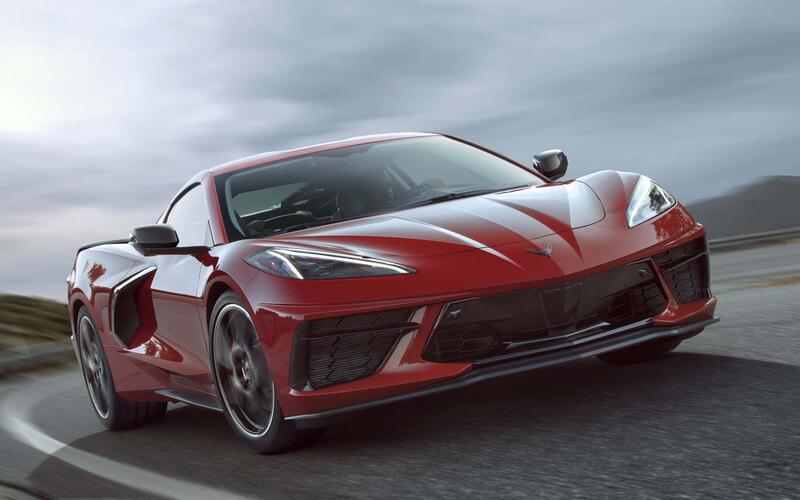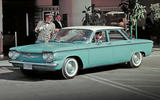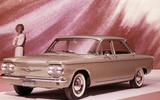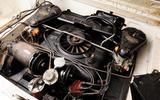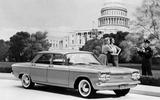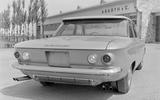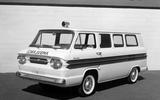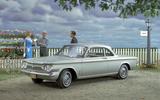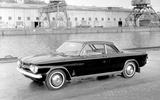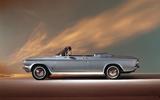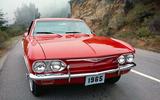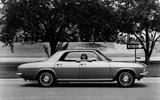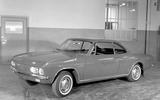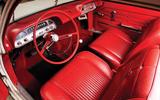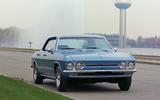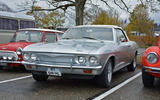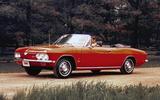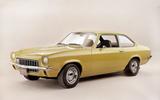 Slide of
Slide of
Chevrolet didn’t set out to design the most controversial American car ever.
When it launched the Corvair project, it wanted to create an entry-level model that rolled value, practicality and performance into a package that looked like nothing else on the road. It was Chevrolet’s first rear-engined car, though many believed it wouldn’t be its last, and it received an air-cooled flat-six engine that no other mass-produced American car could brag about. The Corvair bridged the automotive gap between Europe and the United States.
Ralph Nader’s 1965 book Unsafe at Any Speed torpedoed the Corvair and demonized nearly everyone involved in its development. It irreparably damaged the car’s reputation and sales never recovered. Nonetheless, nearly 1.8 million Corvairs were produced. Was it unsafe or misunderstood? Now 61 years old in 2020, let's take a look at the car and the real story:
 Slide of
Slide of
Ed Cole’s rear-engined dreams (1950s)
Ed Cole, a prominent General Motors engineer and executive, is often considered the father of the Corvair. He had pushed the company to make a rear-engined car for many years before launching the project. He was notably part of a small team that developed a rear-engined Cadillac immediately after World War II. One of the prototypes built was fitted with dual rear wheels for increased stability. While the car never reached production, Cole’s interest in the rear-engined layout didn’t fade.
 Slide of
Slide of
Getting Chevrolet go to rear-engined (1955)
In 1955, while he served as Chevrolet’s chief engineer, Ed Cole argued there was a market for a compact, rear-engined car that was lighter, smaller and cheaper than any model in the automaker’s range. It was clear he had the Volkswagen Beetle and other European imports in mind but it was also clear he wouldn’t settle for copying an existing design. The car he envisioned at the bottom of the Chevrolet line was new and innovative.
Instead of waiting for management’s approval, Cole became the management. He launched the Corvair project when he took the top job at Chevrolet in 1956. He started by assembling a team of engineers and designers he trusted and had worked with before and he put Kai Hansen in charge of the project.
 Slide of
Slide of
Born on a blank slate
Kai Hansen’s team started from scratch. Moving the engine to the back gave designers the freedom to draw a car that looked like nothing else on the road thanks in part to an elegant, grille-less front end. The Corvair didn’t need a bulky transmission tunnel because four-wheel drive certainly wasn’t planned so it offered an unusually roomy interior with space for six passengers. And, significantly, Hansen envisioned the Corvair as a full range of models early on in the development process.
 Slide of
Slide of
The Corvair’s introduction
The Corvair went on sale across America in the fall of 1959 as a 1960 model. The line-up quickly grew to include three basic trim levels named 500, 700 and 900, respectively, numbers that corresponded to Standard, Deluxe and Monza (essentially entry-level, mid-range and performance) models. Buyers could choose between two- and four-door body styles. The four-door 700-Series (pictured) outsold its peers by a wide margin; it accounted for about 139,000 of the 250,000 units sold during the 1960 model year.
 Slide of
Slide of
The original Corvair, by the numbers
Chevrolet released the Corvair with an aluminum, air-cooled flat-six engine mounted behind the rear axle. The 2.3-liter six sent 80 hp to the rear wheels through a three-speed manual transmission, though 83.5% of buyers paid $146 (about $1260 in 2019) for a two-speed Powerglide automatic transmission. Horsepower was cheap during the 1960s; Chevrolet offered a 95 hp evolution of the flat-six at an extra cost for $27 (approximately $230 in 2019).
The two-door 500-Series model represented the entry point into the Corvair range. It cost $1984 (about $17,000 in 2019) during its inaugural model year. At the other end of the spectrum, the 900-series Corvair Monza started at $2238 (roughly $19,000 in 2019).
The Corvair’s main rivals were the Ford Falcon and the Valiant that Chrysler briefly sold as a standalone model before slotting it at the bottom of the Plymouth line-up. Both were introduced during the 1960 model year and they adopted a more conventional front-engined, rear-wheel drive layout. PICTURE: Corvair with an Abarth exhaust.
 Slide of
Slide of
New for 1961
Kai Hansen’s vision of a full line of Corvair-badged models became a reality during the 1961 model year. Chevrolet released a station wagon called Lakewood (pictured) with a spacious cargo compartment above the engine and a second one up front. The firm also launched a pair of commercial, cab-over models not unlike the Volkswagen Bus named Corvair 95 in reference to the 95in wheelbase.
The Corvair 95 range was split into several models. The Corvan was a panel van, the Greenbrier had windows and up to nine seats while the Loadside and Rampside were pickups. The Rampside featured an innovative folding side panel that made rolling cargo into the bed a breeze. All of the new additions to the Corvair range used the same 80 hp as the two- and four-door models released a year earlier.
 Slide of
Slide of
The one-car accident (1960s)
It didn’t take long for reports of motorists spinning, rolling and sometimes dying in their Corvair to make headlines in the United States. Well-known comedian Ernie Kovacs died in 1962 after skidding his Corvair Lakewood sideways into a telephone pole. While police said he may have lost control while reaching for a cigar, many quickly blamed his death on the car’s rear suspension.
About 64% of the Corvair’s weight was over the rear wheels so it was terrifically prone to oversteering. Each half-shaft was connected to the differential via only one inboard universal joint. This layout meant weight transfer caused the rear wheels to tuck in under hard cornering and the back end had a tendency to break loose without warning. Some aftermarket companies (including EMPI) toned down this perceived issue by developing a stabilizer bar for early examples of the Corvair that promised to keep body roll in check.
Chevrolet argued its engineering department wasn’t to blame and said owners rarely kept the tires properly inflated. The owner’s manual (which Chevrolet reluctantly admitted no one read) stated the front and rear tires should be filled to 15psi and 26psi, respectively.
 Slide of
Slide of
An internal fight (1960s)
General Motors employees sang a different tune behind closed doors. The Corvair tore open a sizeable rift in the middle of the company’s headquarters with the marketing team on one side and the engineering team on the other. The two sides grew further apart in the wake of the car’s unveiling.
“Albert Roller tested the car and pleaded with me not to use it at Pontiac. Roller had been an engineer with Mercedes-Benz before joining GM, and he said that Mercedes had tested similarly designed rear-engined, swing-axle cars and had found them far too unsafe to build,” wrote John Z. DeLorean in his 1979 book On a Clear Day You Can See General Motors.
While no one managed to talk Ed Cole out of building the Corvair, DeLorean vetoed the plan to turn it into a Pontiac. The company spent $1.3 million (about $11 million in 2019) to make a Pontiac-badged Corvair and locked in a 1960 release date but ultimately canceled the project due to safety concerns.
 Slide of
Slide of
Sports car on a budget (1962)
Much to Chevrolet’s surprise, the Corvair often attracted relatively young buyers looking for a sports car with a budget-friendly price. Many two-door models were ordered with bucket seats, for example.
Sensing a growing demand for performance, Chevrolet made an optional equipment package named Spyder available on the Corvair Monza in 1962. It brought an high-performance evolution of the six daringly turbocharged to 150hp. The Corvair Monza Spyder arrived in showrooms more than a decade before BMW, Porsche and Saab released their own turbocharged sports cars.
 Slide of
Slide of
The calm before the storm (1962)
Delivering a blend of performance and value kept sales healthy. Chevrolet axed the Lakewood variant and launched a convertible Corvair during the 1962 model year yet sales reached 306,000 units. The fact that the convertible was more popular than the station wagon spoke volumes about the Corvair’s image.
The Corvair’s success didn’t go unnoticed in Detroit. It inspired Ford to develop its own attainable sports car, an emblematic model that played a significant role in squashing the popularity of Chevrolet’s only rear-engined car: the Mustang.
 Slide of
Slide of
The 1964 changes
The Corvair’s critics progressively got louder during the early 1960s and Chevrolet couldn’t keep them on mute for very long. Over 100 lawsuits had been filed against General Motors by motorists who crashed a Corvair or family members of drivers who died in one.
The 1964 model year consequently brought a redesigned rear suspension with a transveraslly-mounted leaf spring that reduced body roll plus a standard front stabilizer bar. That same year, all variants of the Corvair received a 2.7-liter flat-six tuned to 95 hp. The 150 hp Spyder remained available.
 Slide of
Slide of
The second-generation Corvair (1965)
The redesigned second-generation Corvair made its debut in late 1964 as a 1965 model. The coupe, convertible and sedan variants stood out with a much sharper design that placed a stronger emphasis on performance while continuing to look like nothing else on American roads at the time. The Loadside and Rampside trucks (axed in 1963 and 1964, respectively) didn’t return. The message was clear: the Corvair was an entry-level sports car and needed to be seen as one. After all, Ford didn’t offer the Mustang as a pickup.
Even bigger changes were found under the sheet metal. Engineers drew inspiration from the Corvette to develop a four-link rear suspension that gave the Corvair more sure-footed handling, even when it was pushed to the limits. Changes were also made to the front suspension and to the steering system.
 Slide of
Slide of
The second-generation Corvair, by the numbers (1965)
No one complained about the Corvair’s engine so Chevrolet largely left it alone. The 2.7-liter, air-cooled flat-six still sent 95 hp to the rear wheels through a three-speed manual transmission. Buyers looking at the entry-level Corvair 500 or the mid-range Monza could pay $27 (about $220 in 2019) for a 110 hp version of the six.
Bumping the Monza down to mid-range status cleared space for a true range-topping model named Corvair Corsa. Offered only as a coupe and as a convertible, it picked up where the turbocharged Spyder left off with a naturally-aspirated, high-compression evolution of the standard six tuned to 140 hp thanks in part to four single-barrel carburetors. Better yet, $161 (about $1500 in 2019) bought a 180 hp, turbocharged flat-six that transformed the the Corvair the only rear-engined muscle car ever made.
Chevrolet sold 235,500 examples of the Corvair during the 1965 model year, up from 199,387 units the previous year. It looked like the updates would keep Corvair sales healthy in the foreseeable future.
 Slide of
Slide of
The Corvair in Europe
While the Corvair is a rare sight on European roads, and most of the ones registered in Europe were imported from the United States by vintage car enthusiasts, Chevrolet manufactured a handful of examples for the local market in Bienne, Switzerland. Key details (including production figures) are long lost to history. The Chevy II, the Camaro and the Chevelle were also made in Bienne until the facility stopped making Chevrolet-badged cars in 1968 to focus on Opel and Vauxhall better aligned with European tastes.
In France, a four-door Chevrolet Corvair started at 22,000 francs in 1965. To add context, Citroën charged 5079 francs for the cheapest 2CV and Jaguar’s E-Type coupe carried a base price of 43,100 francs. The Corvair competed in the same segment as the AMC-developed Rambler that Renault made in Belgium, the Rover 2000 and the Mercedes-Benz 220S (W111).
 Slide of
Slide of
Unsafe at Any Speed (1965)
Attorney, lobbyist, consumer advocate, former Corvair owner, and serial presidential candidate Ralph Nader published a book titled Unsafe at Any Speed which damned nearly everybody with even vague, indirect ties to the American automotive industry. It was released in late 1965, a little over a year after Chevrolet fully redesigned the Corvair, and it became a best-seller. While Nader’s tirade wasn’t specifically about the Corvair, he dedicated the entire first chapter of his book to the car’s handling problems. Worse yet, he accused General Motors officials of signing off the Corvair even though they knew it was dangerously tricky to handle in order to save money and meet their profit targets.
“For the past 35 years, American cars have been designed so as to be basically understeering. The Corvair was the first mass-produced exception. [Kai Hansen’s group] did not have the professional stamina to defend their engineering principles from the predatory clutches of the cost cutters and stylists. They didn’t forget about the driver; they ignored him,” Nader wrote.
 Slide of
Slide of
The Electrovair II
As Chevrolet’s legal department tried to keep the Corvair scandal from spinning out of control, its engineering department fine-tuned a battery-powered prototype named Electrovair that they built as a rolling display of technology. The original Electrovair made in 1964 suffered from many shortcomings but the Electrovair II (pictured) released in 1965 was much closer to car Chevrolet could sell to the general public. It was never seriously considered for mass production, however.
Based on a second-generation four-door Monza, the Electrovair II traded its flat-six for an AC induction motor that drew power from a 532-volt silver-zinc battery pack installed over the front wheels. It had an 80mph top speed even though it weighed 800lb more than a stock Corvair. It could drive for anywhere between 40 an 80 miles on a single charge.
 Slide of
Slide of
The aftermath of Nader’s book (late 1960s)
General Motors first tried silencing Ralph Nader by intimidating him. It then allegedly hired women to seduce him, wire-tapped his telephone and kept him under constant surveillance hoping to catch him doing something illegal that it could use as a bargaining chip. The harassment campaign didn’t work; it predictably back-fired. Nader later sued General Motors and settled out of court for $425,000 (about $3 million in 2019 money).
Unsafe at Any Speed had a disastrous effect on the Corvair’s career. Sales fell to 103,743 units for the 1966 model year and collapsed further to 27,253 units the following model year. Chevrolet frantically tried to turn sales around by reshuffling the line-up; the flagship Corsa disappeared during the 1967 model year and the four-door model retired for the 1968 model year, leaving only the coupe and the convertible to carry the torch. Only 15,400 examples of the car were sold during the 1968 model year.
 Slide of
Slide of
The last Corvairs (1969)
For the 1969 model year, the Corvair’s last, the line-up was reduced to two coupes and one convertible. Only about 6000 cars were made. Interestingly, in May 1969 dealers started giving Corvair buyers $150 coupons (about $1000 in 2019) that they could redeem when purchasing a new Chevrolet. It was valid until 1973. The company’s marketing team hoped the coupons would help owners accept the fact that their Corvair would lose value on the used car market once the nameplate retired.
Production ended in 1969 after Chevrolet made 1,786,243 examples during a 10-year run. As controversial cars go, this counts very much as a success, overall.
 Slide of
Slide of
The Corvair’s legacy (1970s)
In a way, Chevrolet got lucky. The Corvair retired when even the most loyal supporters of the rear-mounted engine were beginning to call their allegiance into question. Across the pond, Fiat, Volkswagen, Renault, Simca, NSU and others had either launched a front-engined, front-wheel drive model or were experimenting with the layout. Chevrolet saw no reason to continue investing in a technology that risked becoming obsolete sooner rather than later.
The Corvair’s spot at the bottom of the Chevrolet line-up was filled by the Vega (pictured) introduced in 1970. Front-engined and rear-wheel drive, it was a completely different kind of entry-level model that was smaller than the Corvair and more efficient. It later suffered from a diverse selection of problems that made the Corvair look like a superb example of engineering.
 Slide of
Slide of
Vindicating the Corvair (1972)
The Corvair saga didn’t end when its production line fell silent. In 1970, the National Highway Traffic Safety Administration (NHTSA) asked the Texas A&M University for help in looking into the model’s alleged handling deficiencies. The final, 143-page report published in 1972 exonerated the 1960-1963 Corvair by concluding it “compares favorably with contemporary vehicles used in the test.”
Researchers wrote “the Corvair understeers in the same manner as conventional passenger cars up to about 0.4g lateral acceleration and makes a transition from understeer, through neutral steer, to oversteer in a range from about 0.4g to 0.5g lateral acceleration.” Testing carried out in Texas showed the transition did “not result in abnormal potential for loss of control.”
 Slide of
Slide of
In a class of one
As of 2019, General Motors still hasn’t released another rear-engined car and there’s no reason to believe it ever will. At best, it might launch an electric car with a rear-mounted motor.
The Corvair is a true oddity in General Motors history. The only other series-produced cars the company designed with an engine mounted behind the driver are the 1984-1988 Pontiac Fiero, which gained an unenviable reputation for being prone to catching fire, and the eighth-generation Chevrolet Corvette going on sale for the 2020 model year. Both are mid-engined.
Was the Corvair really unsafe at any speed, or simply misunderstood?
Advertisement


